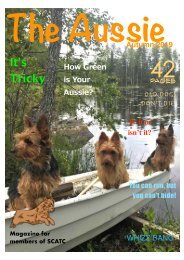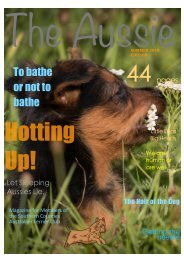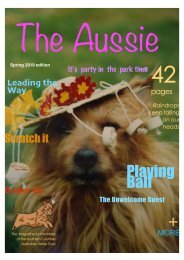The Aussie Magazine Autumn 2020
For members of the Southern Counties Australian Terrier Club
For members of the Southern Counties Australian Terrier Club
Create successful ePaper yourself
Turn your PDF publications into a flip-book with our unique Google optimized e-Paper software.
Mushrooms and fungi
We all know that many dogs just love to eat anything.
Scavenging is something lots of dogs enjoy doing. As vets
we are oden asked about wild mushrooms.
With the milder climate and the recent rain plus people
who have not walked in the area previously, the reports of
Even in gardens.
Most species of wild mushrooms in the UK are edible.
That’s why at this Jme of year so many people in the
know are out and about in their secret locaJons hunJng
for these valuable commodiJes. But anyone who has read
an Agatha ChrisJe, or some other murder mystery, will
know there are others are extremely dangerous – sadly it
is not easy to tell the difference between the two.
These toxic varieJes contain a mushroom poison similar to
mycotoxin (the toxin contained in mould which is also
harmful to dogs).
Death cap (Amanita Phalloides) and Fool’s funnel
(Clitocybe rivulosa) are among the most likely to cause
toxic symptoms, with the la2er regularly growing on lawns
this Jme of year.
Symptoms can vary dramaJcally depending on what was
eaten, and can range from dribbling, vomiJng or
diarrhoea, blood in the stools or vomit, neurological
effects such as hallucinaJons or fits, kidney or liver failure.
Myth: Snails, insects or other animals won’t eat poisonous
mushrooms.
Fact: Just because a mushroom doesn’t hurt another animal
doesn’t mean it won’t hurt you.
Myth: Silver or onions blacken toxic mushrooms on touch.
Fact: All mushrooms darken or bruise if damaged.
Myth: Toxic mushrooms smell and taste horrible.
Fact: Some say toxic mushrooms actually taste very good.
Myth: Any mushroom becomes safe if you cook it.
Fact: You can’t make a toxic mushroom safe by cooking,
canning, freezing or drying.
It is best to consider all wild mushrooms potenJally toxic to
dogs and seek veterinary advice if your pet is suspected to
have ingested any. If your dog does eat a wild mushroom,
take them to the vets immediately. If you can, take along the
following:
> A photo of the mushroom
> A descripJon of where it was found growing i.e. on grass, in
shade or in a tree stump
> The mushroom wrapped in paper – not plasJc
The kind of mushroom that has been ingested will affect
how long these symptoms take to display – someJmes it
can be very rapid.
If your dog is prone to foraging and eaJng anything in
sight, avoid wooded shady areas where wild mushrooms
are more likely. If your dog is a parJcularly keen scavenger,
some owners have found success using a basket muzzle.
Although, we realise this is not always easy to train a dog
to be comfortable with one. Plus some owners find other
dog walkers assume your dog is unfriendly. But this is an
opJon.
Death Cap mushrooms (Amanita Phalloides) in
various stages of their growth.
There are lots of myths about mushrooms that you may
find when out and about.
Poisonous Mushrooms: Myths vs. Facts
And then there’s the lore. People pass along
misinformaJon about how to disJnguish edible
mushrooms from poisonous species, like the following:
Myth: Poisonous mushrooms always have bright, flashy
colours.
Fact: Toxic species can be pure white or plain brown.
Fools Funnel Mushrooms which are being found
more commonly in gardens.









